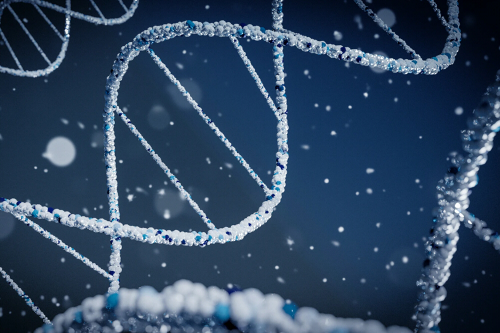Family Stories with Fingerprintless Genetic Heritage
“无指纹”基因遗传家族的故事
Apu, who is 22 years old, lives with his family in a village in the northern district of Rajshahi1. He is currently working as a medical assistant. Meanwhile, his father and grandfather are farmers.
22岁的阿普与家人住在拉杰沙希市北区的一个村庄里。他目前是一名医务助理,他的父亲和祖父则是农民。
All the men in his family seem to have very rare genetic mutations2, thought to be experienced by only a small number of families around the world, that is, they don’t have fingerprints.
他的家族中,所有男性似乎都有非常罕见的基因突变,世界上仅有少数家族被认为患有这种基因突变——天生没有指纹。
When his grandfather was young, not having fingerprints was not a big problem.
阿普的祖父年轻那会儿,没有指纹没什么大不了。
But in today’s modern era, the tiny grooves3 that rotate around the tip of a human finger in general, known as dermatoglyphs4, have become the world’s most widely collected biometric5 data. We use it for everything from things to do at airports to voting in elections and unlocking our smartphones.
然而在当今这个时代,人类指尖通常呈螺旋状的小小纹路——被称为“皮纹”——已然成为世界上采集范围最广的生物特征数据。从机场通关到选举投票和解锁智能手机,事事都要用上指纹。
In 2008, when Apu was a child, Bangladesh introduced a national identity card for adults with a database that required a thumbprint. The confused officers didn’t know how to process the identity card for Apu’s father, Amal Sarker. Finally, he received a card with the stamp “WITHOUT FINGERPRINT”.
2008年,当时阿普还是个孩子,孟加拉国开始推行成人国民身份证,其数据库要求采集拇指指纹。面对阿普的父亲阿迈勒·萨卡尔,工作人员很为难,不知该如何为其办理身份证。最终,他拿到了一张加盖“无指纹人士”印章的身份证。
In 2010, fingerprints became a mandatory requirement for passports and driving licenses (SIM6). After several tries, Amal was able to get a passport by showing a certificate from the health agency. He never used it, partly because he was afraid he might have trouble at the airport.
2010年,申领护照和驾照必须提供指纹。几经尝试,阿迈勒通过出示健康机构出具的证明才领到护照。但他从没用过护照,部分原因是他怕在机场还会遇到麻烦。
And although riding a motorbike was essential for farming work, he never had a driver’s license. “I’ve paid the fee, passed the exam, but they didn’t issue a permit because I couldn’t provide fingerprints,” he said.
虽说骑摩托车在干农活的时候必不可少,但他的驾照一直没办下来。“我交了钱,通过了考试,但他们没给我发证,就因为我提供不了指纹。”他说。
In 2016, the government of Bangladesh made fingerprint matching with a national database mandatory for those who wish to get a SIM7 card for their cell phone.
2016年,孟加拉国政府规定,购买手机卡的用户必须在国家数据库中进行指纹匹配。
“They looked confused when I came to buy a SIM (card), their software crashes every time I put my finger on the sensor,” said Apu with a wry smile. Apu’s desire to get a SIM card was rejected, and all male members in his family now use a SIM card issued in his mother’s name.
“我去买手机卡的时候,他们看起来很为难,每次我把手指放在传感器上,软件就崩溃。”阿普苦笑着说。阿普一直无法如愿买到手机卡。家族中所有男性成员目前使用的手机卡都登记在阿普母亲的名下。
The rare condition experienced by the Sarker family is called Adermatoglyphia8. It first became widely known in 2007 when Peter Itin, a dermatologist9 in Switzerland, was contacted by a woman who was having trouble entering the US.
萨卡尔家族所患的这种罕见病症被称为“皮纹病”。这种病是从2007年开始广为人知的。当时,一名女子在入境美国时遇到麻烦,便联系到了瑞士皮肤病专家彼得·伊京。
Her face matched the photo in her passport, but the customs officer could not record any fingerprints, because she did not have one. After examination, Professor Itin found that the woman and 8 members of her family had unique conditions, namely flat finger surfaces and reduced number of sweat glands10 on the hands.
她的脸与护照上的照片对得上,但海关人员无法采集到任何指纹,因为她根本没有指纹。经过检查,伊京教授发现该女子与其家族中8名成员身上均有某些独特的症状,即手指表面平滑,手部汗腺较少。

Working with another dermatologist, Eli Sprecher, and graduate student Janna Nousbeck, Professor Itin looked at DNA from 16 family members. Nine of them had no fingerprints.
伊京教授与另一位皮肤病专家叶利·斯普雷彻以及研究生扬娜·诺斯贝克合作,仔细研究了该女子所在家族16名成员的DNA,其中9人没有指纹。
In 2011, the team found one gene, SMARCAD1, that was mutated in the 9 family members without fingerprints. They identified it as the cause of the rare disease. Almost nothing was known about the gene at the time. The mutations do not appear to cause any ill health effects, apart from the effects on the hands.
2011年,研究小组在没有指纹的9名家族成员身上发现了一种产生突变的基因SMARCAD1。他们认定,它就是造成这种罕见病症的原因。当时,人们对这种基因几乎一无所知。这种基因突变除了对手部有影响外,似乎对健康没有任何不良影响。
Once discovered, the disease was called Adermatoglyphia, but Prof. Itin dubbed11 it an “immigration delay disease”, after his first patient had difficulty getting to the US.
这种病症一经发现便被命名为“皮纹病”,而伊京教授将其戏称为“入境延误症”,因为他的首例患者是在入境美国时遇上麻烦才被发现的。
For the Sarker family, who is suffering from this rare condition, the community seems to be becoming more hostile12 rather than accommodating13 to their condition. Amal Sarker lived most of his life without too much trouble, he said, but he felt sorry for his children. “This is not my hand, this is something I inherited,” he said.
对于患有这一罕见病症的萨卡尔家族,社会似乎越来越不待见他们,而不是给他们行方便。阿迈勒·萨卡尔说,他大半辈子都没因这病遇上过什么大麻烦,可他对孩子们却感到愧疚。“这双手不是我能决定的,是遗传来的。”他说。
Recently Amal and Apu got a new type of identity card issued by the Bangladeshi government after they presented a medical certificate. The card also uses biometric data, retina14 and facial scans.
前不久,阿迈勒和阿普在递交了医学证明后,拿到了孟加拉国政府颁发的一种新型身份证。这种身份证也使用生物特征数据——视网膜和面部扫描图。
However, they still can’t buy a SIM card or get a SIM, whereas the process of getting a passport is a long and tedious15 process. “I am tired of explaining the situation again and again. I asked many people for advice, but none of them could give me a definite answer,” said Apu.
然而,他们仍然买不到SIM卡,也领不到驾照,而申领护照的手续既费时又烦琐。“我厌烦了一遍又一遍地解释我的情况。我咨询过很多人,但谁也给不了明确的答复。”阿普说。
“Someone advised me to go to court. If all options fail, that’s probably what I will do.” Apu hopes he can get a passport, he said. He wants to travel outside Bangladesh. He just needs to start submitting the application.
“有人建议我上法院。要是所有办法都行不通,我很可能就会上法院。”阿普说他希望能领到护照。他想出国旅行。他要做的就是开始提交护照申请。
(译者为“《英语世界》杯”翻译大赛获奖者)
注释:
1. 孟加拉国中西部工商业城市。
2. mutation 突变。
3. groove 纹。
4. dermatoglyph 皮纹。
5. biometric 生物统计的。
6. = Surat Izin Mengemudi[印尼]驾照。
7. = Subscriber Identity Module.
8. adermatoglyphia 皮纹病。
9. dermatologist 皮肤病专家。
10. gland 腺。
11. dub 把……戏称为。
12. hostile 敌对的。
13. accommodating 与人方便的。
14. retina 视网膜。
15. tedious 冗长的。








